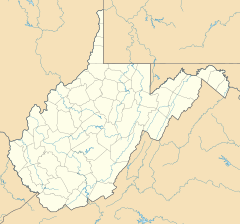Belleville, West Virginia facts for kids
Quick facts for kids
Belleville
|
|
|---|---|
| Country | United States |
| State | West Virginia |
| County | Wood |
| Elevation | 594 ft (181 m) |
| Time zone | UTC-5 (Eastern (EST)) |
| • Summer (DST) | UTC-4 (EDT) |
| ZIP code |
26133
|
| Area code(s) | 304 and 681 |
| GNIS feature ID | 1553848 |
Belleville (sometimes spelled Belville) is a small community in Wood County, West Virginia, United States. It's an "unincorporated community," which means it doesn't have its own local government like a city or town. Instead, it's part of the larger county.
Contents
Powering Up: Belleville's Hydroelectric Plant
Belleville is home to a special power plant called Belleville HydroElectric. This plant uses the power of moving water to create electricity. It's located on the east side of the Belleville Locks and Dam.
The plant started working in April 1999. It can produce 42 megawatts of electricity. That's enough power for many homes and businesses! The United States Army Corps of Engineers operates the dam, while American Municipal Power, Inc. (AMP) runs the power plant.
A Look Back: Belleville's History
Belleville has a long and interesting history, stretching back hundreds of years.
Who Lived Here First?
Long before European settlers arrived, Native American tribes lived in the area that is now West Virginia. In the late 1500s and early 1600s, the Huron people lived here. Later, the Iroquois Confederacy, a powerful group of Native American tribes, took over the land. They mostly used it for hunting.
When the first European settlers came, no single Native American tribe lived in the Ohio Valley permanently. Different tribes, like the Delaware, Shawnee, and Miami, used the area for hunting and fishing. They had traditions of living near the Ohio River, but conflicts with the Iroquois made it a shared hunting ground.
Early European Exploration and Land Claims
In 1744, officials from Virginia bought land west of their colonial border, reaching all the way to the Ohio River. This was part of a deal with the Iroquois called the Treaty of Lancaster.
During the French and Indian War (1755-1763), some Native American tribes sided with the French. After the war, England's King George III wanted to prevent more fighting between settlers and Native Americans. So, in 1763, he issued a "Proclamation." This rule said that settlers could not move west of the Allegheny Mountains without special permission.
Later, in 1768, another agreement called the Treaty of Fort Stanwix opened up more land south and east of the Ohio River for settlement. Even so, it was still hard to legally own land until 1779. This makes it tricky to know exactly who the very first permanent European settlers were.
George Washington's Connection
Did you know that George Washington once owned land in Belleville? In 1769, Captain William Crawford surveyed lands for Washington. Washington had been given over 9,000 acres along the Ohio River for his service in the French and Indian War. This included the land where Belleville is now.
In 1770, Washington himself traveled down the Ohio River to explore the area. He officially received the land grant in 1772. Later, Washington sold this land to a company that planned to develop it.
Founding the Settlement
In 1785, a man named William Tilden, who owned a lot of land along the Ohio River, teamed up with Joseph Wood. Wood's job was to find people to settle the land. In the fall of 1785, an expedition left Pittsburgh. It included Tilden, Wood, four families from Pennsylvania, and some hired workers.
They sailed down the Ohio River and landed in what is now Belleville on December 16, 1785. They built a strong wooden fort, called a "block house," surrounded by a protective fence, or "stockade." Over the next year, they cleared land for farming and built cabins. They named their new home Belleville.
Some of the first settlers included James Pewthewer, William Ingals, and David Jemerson. More families joined them in 1787. Around 1796 or 1797, more immigrants arrived from Connecticut. One of them was George D. Avery, a surveyor. He built a mill on nearby Lee Creek in 1803, which helped the community grow.
Belleville During the Civil War
Belleville saw some action during the American Civil War. On July 19, 1863, Confederate General John H. Morgan tried to cross the Ohio River here. He was trying to escape after a raid through southern Ohio.
However, Union forces were waiting. Two Union boats, the gunboat Moose and the armed steamer Allegheny Belle, stopped Morgan's troops. About 300 of Morgan's raiders managed to cross into West Virginia. The rest followed General Morgan into northern Ohio.
See also
 In Spanish: Belleville (Virginia Occidental) para niños
In Spanish: Belleville (Virginia Occidental) para niños



